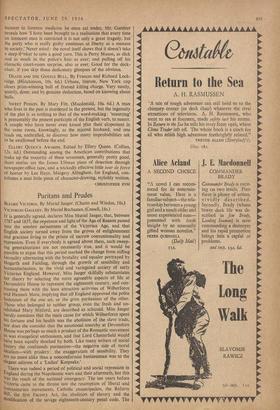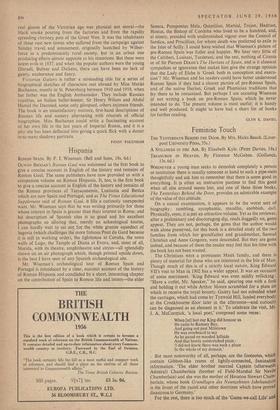Puritans and Prudes
1r is generally agreed, declares Miss Muriel Jaeger, that, between 1787 and 1837, the sweetness and light of the Age of Reason passed into the sombre earnestness of the Victorian Age, and that English society turned away from the groves of enlightenment and gracious living to the prison of narrow conventionality and repression. Even if everybody is agreed about them, such sweep- ing generalisations are not necessarily true, and it would be Possible to argue that this period marked the change from stifling formality alternating with the brutality and squalor portrayed by Hogarth and Fielding, through the growth of sensibility and humanitarianism, to the vivid and variegated society of early Victorian England. However, Miss Jaeger skilfully substantiates her theory by selecting the more agreeable aspects of life at Devonshire House to represent the eighteenth century, and con- trasting them with the least attractive activities of Wilberforce and Hannah More, implying that all England approved the polite hedonism of the one set, or the grim puritanism of the other. Those who belonged to neither group, even the fresh and un- inhibited Mary Mitford, are described as schizoid. Miss Jaeger hardly mentions that the main cause for which Wilberforce spent his fortune and his health was the abolition of the slave trade, itor does she consider that the emotional anarchy at Devonshire House was perhaps as much a product of the Romantic movement as was evangelical enthusiasm, and that LOrd Chesterfield would have been equally shocked by both. Like many writers of social history she confounds puritanism—the negative side of moral idealism—with prudery : the exaggeration of sensibility. They are no more alike than a nonconformist businessman was to the elegant editress of a 'Ladies' Keepsake.'
There was indeed a period of political and social repression in England during the Napoleonic wars and their aftermath, but this was the result of the national emergency. The ten years before Victoria came to the throne saw the resumption of liberal and humanitarian movements, Catholic emancipation, the Reform 11111, the first Factory Act, the abolition of slavery and the modification of the savage eighteenth-century penal code. The
real gloom of the Victorian age was physical not moral—the black smoke pouring from the factories and from the rapidly spreading chimney pots of the Great Wen. It was the inhabitants of these vast new towns who suffered from the campaign against Sunday travel and amusement, originally launched by Wilber- force in a predominantly rural society, but in an urban one producing effects almost opposite to his intentions. But these were latent evils in 1837, and when the popular authors were the young Disraeli, Bulwer and Dickens, there can have been no lack of gaiety, exuberance and fancy.
Victorian Gallery, is rather a misleading title for a series of biographical sketches of characters met abroad by Miss Meriel Buchanan, mostly in St. Petersburg between 1910 and 1918, when her father was the English Ambassador. They include Russian royalties, an Italian ballet-Tnaster, Sir Henry Wilson and Abdul Hamid the Damned, some only glimpsed, others intimate friends. The book is an unsatisfactory mixture, first-hand descriptions of Russian life and scenery alternating with rewinds of official biographies. Miss Buchanan could write a fascinating account of her own life in the last years of Imperial Russia, and it is a pity she has been deflected into giving a quick flick with a duster to so many shadowy portraits.
PANSY PAKENHAM



































 Previous page
Previous page